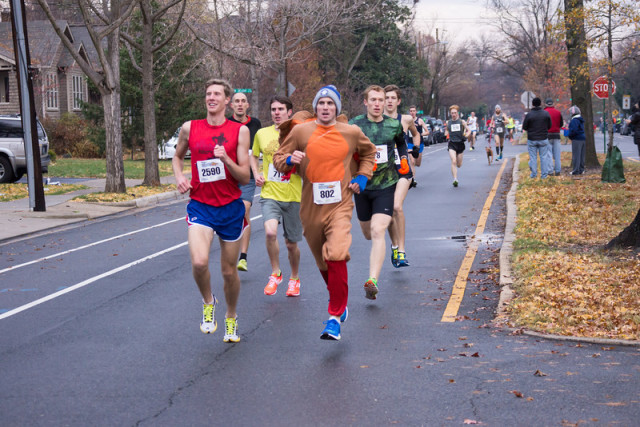
On a holiday renowned for gluttony, the winners at the Alexandria Turkey Trot ended up getting just enough, not too much.
For Kevin McNab, it meant a narrow win over Georgetown University cross county runner Collin Leibold, both timed at 24:32. For Susanna Sullivan, all she really needed was one second by which to break the women’s course record — 27:13.
All the excess came in the turnout, the race’s second biggest in its 39 years. Nearly 4,000 participants finished, and their entry fees went to benefit the ALIVE food charity.
[button-red url=” http://www.zippyraceresults.com/search.php?ID=4538″ target=”_self” position=”left”] Results [/button-red]The flat, fast five-mile course traverses the streets of Alexandria’s Del Ray neighborhood. It’s a holiday tradition for families and friends, with a robust dog and stroller contingent. Dedicated residents set up cheering stations in their front yards or along sidewalks to cheer the runners on, their only defense from the cold their winter coats and a bloody mary or two. The race includes a number of sudden turns through the neighborhood, so includes a fair amount of blind spots for the front running contingency.
McNab, of Washington, D.C. leaned in over Leibold, but it didn’t look like it would be that close early on. Twenty seconds behind the lead pack for the first two miles, “I was in no man’s land,” McNabb said, between the first group and another contingent behind him. He closed the gap between three and 3.5 miles and unfurled at a punishing pace from that point on.
It was an elbow-to-elbow scrum of seven runners until the very end. The finish line is a quick veer into the George Washington Middle School’s parking lot, and it came as a surprise to McNab. Leibold, too, was caught off guard by the finish line, saying that he “wasn’t expecting it because it wasn’t starting to hurt yet.” The pre-med major is getting some extra races in after a season shortened by injury.
Sullivan defended her title from 2013, a gratifying win after what she called a “wild fall” which included more time in the pool than the roads due to a stress fracture in her shin. She and second place finisher Mahlet Melese fought it out for a mile and a half but Sullivan pulled out all the stops in the final quarter mile.
Sullivan’s favorite part of the race, after family there to cheer her on, was the crowds of middle-of the pack runners cheering her along on the out and back section of Commonwealth. “I felt like a celebrity,” she said. The conviviality of both runners and spectators is a favorite element of the Alexandria Turkey Trot, and a yearly highlight in the community that claims its “where main street still exists.”
Local legend and elite ultramarathoner Michael Wardian made a new record-breaking effort. He placed first in the 40-49 age group as well as the dog category with his one year old Viszla, Rosie in 27:38. He “let her control her own pace,” said Wardian, who was beaming with pride at his puppy’s debut. While the Alexandria Turkey Trot did not have an official running with dog record category, consensus was that Michael won it, and if next year’s race includes a canine category, Rosie will definitely be the bunny every pup is gunning for.
Of course it wouldn’t be a turkey trot without someone dressed like a turkey, and Alexandrian John Galer not only delivered, but he upped the stakes a little by assembling a team of four pilgrims to chase him. Designated the turkey by the group of 5 because he was fastest, John finished first and waited at the finish line as Emily Galer, AJ Menton, Aanan Patel, and Mike Lucas trickled in.
The group’s plan for the rest of the day consisted of a pilgrimage of sorts – a four-stop Thanksgiving tour of the District and Alexandria. The group, who has been celebrating “Friends-giving” for close to a decade, thought that their pre-emptive calorie burn was sound preparation for their day-long travelling feast. Wherever they end up, the closing note of the tradition is to wind up the night with a viewing of Home Alone, to signify the beginning of the Christmas season.
Whether racing all out for a course record or enjoying the celebratory atmosphere, the participants of the Alexandria Turkey Trot started off their holiday in festive five-mile fashion.
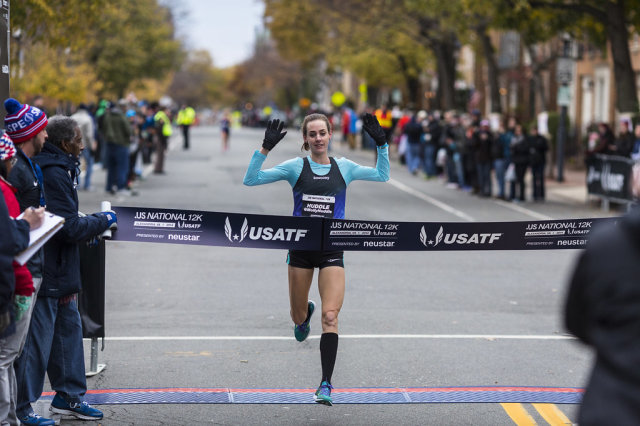
Molly Huddle won her record fourth U.S. title on the roads this year at the .US National 12k Sunday in Alexandria, running 38:08 to repeat as champion at that distance and of the U.S.A. Running Circuit. She won the inaugural 12k event last year in a world’s best 37:50.
[button-red url=” http://www.national12k.us/Results.aspx” target=”_self” position=”left”] Results [/button-red]Her move in the third mile this year put distance on pursuers who included Emily Sisson (38:21), Kim Conley (38:42) and Sara Hall (38:48), all of whom were in striking distance after the race strung out from Huddle’s early pace. By 8k (25:31), she had a 13 second lead over the chase pack, which closed to a 10-second lead over Sisson at 10k (31:57) before she tacked three additional seconds onto her margin in the last 2k.
“I wanted to take it out between 5:00 and 5:10 for the first mile (she hit 5:10) and just see how I felt because I had been a little tired coming into it,” Huddle, 30, said of the cumulative fatigue from the season, which saw her collect national road racing titles at seven miles, 20k and 5k. “I thought I’d just keep it up and see what happened. I just didn’t let up.”
Huddle plans to cut back on road racing early in the year to focus on 10k for the world track and field championships. She set the American Record in the 5k this summer at 14:42.64.
Around toward the end of the third mile, Huddle opened up a one-second gap that strung out Hall, Conley, Sisson and Emily Infeld (sixth, in 39:13). By 5k , Infeld, a Georgetown alumna, had dropped back from the lead group.
“I didn’t really know how it was going until halfway, when I knew people had fallen off, but most of the race I think I just had about a 10-second lead, so if I let up at all, that would go away quickly if I slowed at all,” Huddle said.
Fellow Providence resident and Ray Treacy athlete Sisson, 23, is in her first season of road racing while in Providence College’s MBA program, and made her debut at September’s CVS 5k, the national championship, which Huddle won, and the Tufts 10k in Boston in October.
She trailed Huddle by 10 seconds at 10k (32:07) but carried a 16-second lead over Conley and Hall. Huddle felt that Sisson was capable of this kind of race after her recent workouts, but Sisson herself was trying to avoid any lofty goals early in her road racing career.
“During my first two races, I had a lot of fun and there wasn’t any pressure, but after two you start to look at a pattern and since I ran well, this race got me a little nervous,” she said.“People told me I’d enjoy road racing, and I really do. I love the atmosphere, the feel of the road, the courses.”
After winding through the streets of Old Town Alexandria last year, the 12k course followed the George Washington Parkway south before turning back. That cut down on the turns around which runners could make moves and surprise pursuers, but also gave runners a look at the lead they held.
“I liked the turns last year,” Huddle said. “(This year) you felt like you were going straight for a very long time and I went from mile marker to mile marker. I think the spectators like the out-and-back setup. I got to see what was happening in the men’s race.”
Third place finisher Conley, 28, saw the new course as a challenge. She ran 39:29 last year for fourth place.
“I usually divide a race like this into segments,” she said. “With fewer turns, there were fewer segments. It would have been easier mentally to have shorter straight stretches, but I guess having more turns is harder on your body.”
Conley, of West Sacramento, Calif. was hoping for a slower pace, but held on when Huddle took control from the beginning and battled Hall, 31, of Flagstaff, down the finishing stretch on Union Street. She was a 2012 U.S. Olympian in the 5k, but is adapting to longer distances as she shoots for her half marathon debut in Houston this January.
“There’s a little more time to think in longer races,” she said. “I’m working on being better at concentrating, but there’s a lot of explore(mentally during) these longer races.”
Infeld, 24, of Portland, Ore., watched several Hoya teammates and alumnae race last year while she waited for a diagnosis for an injured back that turned out to be a sacral stress fracture that took her out for six months. She had finished second to Huddle twice in fall 2013, at 5k and 10k.
“It was a long recovery, but I’ve had good training since then,” she said. “Getting back into racing shape takes longer than I thought it would. I felt like I gave it all I had out there, I just don’t have it all back yet.”
Eugene, Ore. runner Alexi Pappas, 24, could sympathize. She is beginning her competitive season, like Huddle focused on the 10k in 2015, and saw the confluence of runners’ seasons play out on the GW Parkway.
“This is my first race (this season), and it’s not to say I didn’t prepare, but this was a challenging step for me,” she said. “I felt like I was brave, I didn’t give up, but I learned a lot, like listening to my own body and running my own race was important.”
She wound up eighth in 39:49, a fair result from a converted steeplechaser. The race field got her motivated for her nascent season.
“With a 5k race, you’ll have some certain runners, and with 15k you’ll have a different crowd, but the 12k really draws this amazing field that blends those groups,” she said. “There were a lot of women in this race that I really admire, so it was an experience I really appreciated. This is the kind of thing that’s getting me fired up for a 10k on the track.”
Frances Koons, 28, of Laurel, Md. was the only local elite runner in the women’s race and she, like Pappas, is getting into the swing of things. She finished 15th in 40:36. In April, she finished third in the U.S. 10 Mile Championships, held in conjunction with the Cherry Blossom Ten Miler.
She recently moved to Maryland to teach and coach at the Sandy Springs Friends School in Silver Spring.
“I just started in September, so things have been a little crazy, but I want to run the Club National Cross Country Championships, so I figured this was local and had fantastic competition, so why not,” she said. “I just wanted to not embarrass myself.”
Though her school lacks a track, she’s training on the school’s 140 acres of grassy fields and soft trails and on a roughly one-mile paved path in a nearby neighborhood.
“I’m getting faster when I run it, whatever distance it is,” she said.
In the masters championship, Perry Shoemaker of Vienna, Va. triumphed in 42:54 comfortably over Chapel Hill’s Alexandra Bigelow (46:24) and a runner from Freeport, Maine named Joan Samuelson.
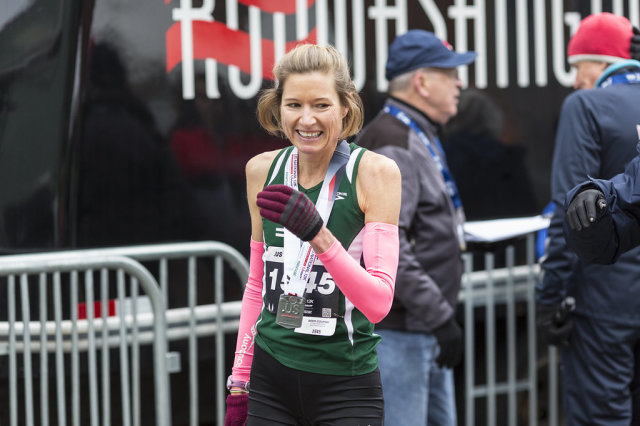

The word Brian Shrader kept saying over and over – to reporters, to friends, to race organizers, and to new fans seeking his autograph – was “shock.”
For example: “I’m still in shock,” he said, after winning the .US National 12k championship in Alexandria this morning. “I don’t even know what to think.”
[button-red url=”http://www.national12k.us/Results.aspx” target=”_self” position=”left”] Results [/button-red]
There were a number of reasons Shrader felt this way.
For one, the top prize paid out $20,000, but the 23-year-old still has track eligibility left at Northern Arizona University. So unless he wants to turn professional, Shrader, according to NCAA rules, can only accept prize money “in an amount up to actual and necessary expenses for the calendar year.” (See this Collegiate Running Association page for a more detailed explanation, but he could keep as much as he can document with receipts, including costs for travel, equipment and coaching.)
Before today, Shrader had never run a 10k, let alone a 12k. He had only run one other road race: the CVS Downtown 5k, the national championship, in September, where he was 4th in 13:59.
Shrader racing the 5k was Northern Arizona University alum Diego Estrada‘s idea. They both live, and occasionally train together, in Flagstaff, Ariz. That day, Estrada unleashed a strong kick to win his first national title, while Shrader qualified to have his expenses covered to compete in the 12k.
On a cold, overcast morning, Shrader, Estrada, and 22 other elite men started around 7:25 on S. Union Street, near Oronoco Bay Park. They headed south to Franklin Street and made a short climb and descent. There, not long after the mile mark, they turned left onto George Washington Parkway, which they followed out to the halfway mark, where they did a U-turn and retraced the same route.
Last year, Aaron Braun, of Alamosa, Colo., came here hungry to win his first national title, setting the tempo for a big lead pack and throwing in a series of surges that allowed him to gradually slip away. He broke the tape in a time of 34:26, which he found out later was just two seconds slower than Steve Spence’s American record.
At yesterday’s press conference, Braun said he was just as fit, if not more fit, than he was in 2013, but also knew he’d have more of a “target on his back.”
That turned out to be true.
In the opening mile, a huge pack, 20-plus strong, formed around him. The consensus, it seemed, was that Braun would be the one pushing the pace while everyone else would be the ones trying not to get dropped.
As 4:40s in the early miles dipped down closer to 4:30 by halfway, the pack started to string out. After the U-turn, Braun threw in a 4:25, his goal being, as with his earlier and later surges, to “try and hurt people a little but also not hurt myself.”
“I needed to be able to put them away earlier,” Braun said, “and make them think it was too big of a gap.”
But back on S. Union Street, when the finish line came into view, Braun, though he had successfully dropped most of the field, was still flanked by five other runners – Shrader, Estrada, Jared Ward, Girma Mecheso, and Parker Stinson – who were snapping out of survival mode and tapping into a far more positive notion: I can win this thing.
Shrader, wearing his NAU singlet, had been executing his strategy of keying off Estrada, hanging on to the lead pack as long as he could, and waiting to see what he had in the end. In the final miles, he tucked closely behind Braun. The last 200 to 300 meters, for him, and for everyone involved, was a blur.
Shrader took the lead; and when his legs tied up, 50 meters or so before the finish, he expected to get caught, but no one came. He won in 34:11, averaging 4:35 per mile, as all six in the final chase pack dipped under what used to be Spence’s American-record time.
Estrada, who had given Shrader the idea to test out road racing, and who missed training time recently due to a sinus infection, was just a second back in 2nd. He said the race played out as he expected.
“I assumed Aaron would push the pace, which happened. And then I figured there would be a few guys with a mile to go; then of course everyone would charge again … But I hesitated a little bit. I wasn’t quite feeling it, and it cost me at the end because I ran out of room,” he said.
Braun, just three seconds back, returned to the podium. “My goal, he said, “was to come back and get the title, number one, and get the record for number two. I got number two, but not number one.”
Mecheso, 5th, gave Braun credit: “The way he ran, he deserved to win,” he said, “because he was pushing all the way.”
Stinson, two seconds behind Mecheso, was inspired by the result, calling it “one of my best races.” Like Shrader, he still has track eligibility, though at University of Oregon.
On one hand, he would’ve liked to have been more competitive during the sprint finish. On the other, he doesn’t envy Shrader.
“I’m glad I didn’t make too much money,” he said, “so I don’t have to make any decisions.”
***
Falls Church native Christo Landry knew his odds of winning his fourth national title in 2014 weren’t good. Five weeks ago he finished 13th in a new personal best of 2:14:30 at the Chicago Marathon, and was still feeling its effects. “I just don’t have the top-end gears right now, coming off the marathon,” he said after finishing 8th in 34:42. “And when you get dropped running 4:35, right after running a 4:32, [you know] they’re running a great time. They ran great, and I just wasn’t hanging with them today.”
For Landry, through, today’s 12k was also a way to celebrate a breakthrough 2014 that gave him an insurmountable lead in the USA Running Circuit (USARC) standings. After the top 10 men were announced, Landry was awarded the $25,000 overall USARC title. He had 82 points, 31 more than Estrada in second.
In the masters division, Arlington’s Michael Wardian won a national title in 38:32. Philippe Rolly, of McLean, was second.
“I don’t ever try to just look to win the masters, but it’s exciting to be in a new age group,” Wardian said.
In typical Wardian fashion, the ultra runner and marathoner was in the Bahamas earlier in the weekend getting in some heat training, he said, and on Friday will represent Team USA at the World 100k championships in Quatar.
“Our team is completely stacked,” he said, “so I think we should win the team title.”
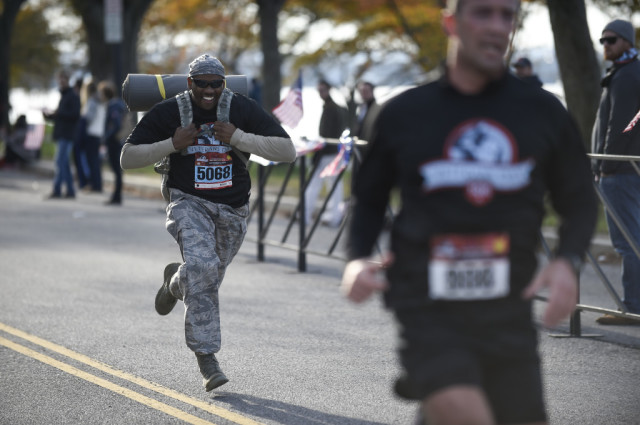
While runners completed the 2014 Veterans Day 10k with varying finishing times, many gave the same response post-race when they described the scenic, 6.2-mile course: fast.
[button-red url=”http://www.zippyraceresults.com/search.php?ID=4486″ target=”_self” position=”left”] Results [/button-red]Pacers/New Balance runner Chris Kwiatkowski of Arlington bested all runners with a 30:11 finish, while 25-year-old Kerri Gallagher finished first among female runners, and 21st overall, with a 33:50 finish.
Kwiatkowski sprinted past last year’s winner Brian Flynn’s time by 1:15.
Washington, D.C. resident Paul Thistle finished behind his Pacers/New Balance teammate at 31:13, and former Georgetown University runner Rachel Schneider trailed Gallagher in 34:48.
The race, largely popular because of its course, attracted more than 1,800 participants whose ages ranged from 11 to 83.
Each runner’s motivation was as diverse as their age.
James Finney Jr. (1:05:18) walked along Lincoln Memorial Circle shortly after crossing the finish line. Finney, an avid runner, placed first in his age group. And perhaps the morning weather was cool enough to wick away his perspiration, but he looked like he barely broke a sweat in the process.
“I run around 20 to 25 races a year,” the 75-year-old Arlington resident said. “I just finished the Marine Corps Marathon on Oct. 26. I ran the Army Ten-Miler on Oct. 12 and I did the Woodrow Wilson Bridge Half Marathon on Oct. 5.
“(Veterans Day) was a perfect race – there was terrific running weather. It was a fast course, there were plenty of water stops and it was very enjoyable.”
Finney, a National Guard employee, said he was pleased with his early-morning performance. “I feel good about my finish. I was shooting for a 1:00:03 finish, and I finished in around 1:00:04, so I was close to my goal time.
He also said he had an external motivation to run well.
“It was honor to run in this race to honor our nation’s veterans. This area, where we ran, is an inspirational area. It really was just a positive experience.”
Not far from Finney stood Ferdinand Duyanen, who donned a black and gold U.S. Army t-shirt. The now-retired service member doesn’t consider himself to be a competitive runner, but said he enjoys the occasional competitive race.
“I’m running for a good cause. I’m out here for my brothers and sisters in the service. This is my second year and it’s a great experience,” said Duyanen, who was deployed to the Persian Gulf for Operation Desert Storm, along with Germany, Japan, Hawaii and other countries throughout his 22 years in the U.S. Army.
“I imagine that there are many others out here today who are doing it for the same reasons as me. Every year I like to come out here and run by the memorials. I’m not a competitive runner at all, but I do enjoy doing this each year.”
But not everyone who ran Sunday morning had ties to the Armed Forces.
Lionel Gloster (1:08:16) first learned about the Veterans Day 10k nearly 11 years ago through a running coach affiliated with the American Stroke Association. Gloster’s mother, Mallie Marie, passed away at age 67 due to heart disease, which prompted him to begin living a healthier lifestyle.
“It was the catalyst,” he said. “People always say that high blood pressure and diabetes run in the African-American community, so I say, ‘Well, we can run it out.’”
Sunday’s race marked Gloster’s sixth. And although he began his Veterans Day 10k experience under somber circumstances, it has blossomed into one that has become far more enjoyable over the years.
“I really like the camaraderie between everyone – the veterans, the young and old. It’s just a great race on a Sunday morning to remember and give thanks to those who gave their lives for us. That’s what this is all about,” the 56-year-old Lanham, Md., resident said.
Gloster also said the yearly races and training regimen have helped him remain free from heart disease.
“Now when I go to the doctor, he tells me that I’m boring. My blood pressure is fine; I don’t have diabetes or any underlying health issues.”
An ebullient Bella Drake (58:13) finished Sunday’s race with a wide smile plastered across her face. The 13-year-old Swanson Middle School student placed second in her age group.
“I really liked that the course was near the water,” she said. “You could even see the airport. I also liked the start of the race since it was near all of the monuments.”
Despite her just being a middle school student, Bella said she occasionally runs with Washington-Lee High School’s cross country team. She aspires to run collegiately at the University of Oregon, like overall winner Kwiatkowski.
“It feels really good,” Bella said of her first Veterans Day 10k race. “I really admire many of the other runners who were out here today.”
Bella’s mother, Theresa (1:16:26), joined her for the race.
“She’s trying to improve her time and she wants to be a good runner and maybe go to college and run,” Theresa Drake, 46, said. “So this year I’ve been signing her up for lots of the races that I run. She’s come a long way. I’m proud of her.”
As the last runners crossed the finish line just before 10 a.m., a group of nearly 30 members and mentors of the Washington, D.C.-based running group Teens Run DC crowded the area to cheer for a teammate who was finishing her first competitive, long-distance run. Leading the chorus of cheers was 17-year-old Ahmed Hassan (46:50), a senior at Woodrow Wilson High School.
Hassan competed in the grueling Marine Corps Marathon just a few weeks earlier, and said he pushed his body to its physical limit to prepare and compete in the Veterans Day 10k. He finished first in his age group.
“I was struggling through it. I wasn’t feeling good at all,” he said. “But it was worth it as I started sprinting at the end. I was so close to first place and I just started sprinting. So it was worth it.”
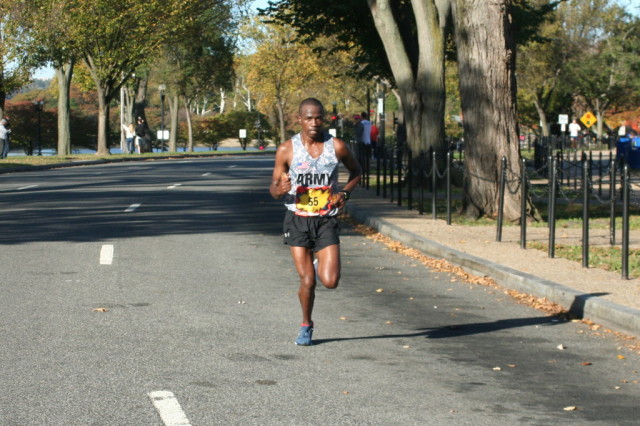
Amid the museums that line the National Mall, Spc. Samuel Kosgei and Capt. Meghan Curran carved out their place in history when they both took leads in the Marine Corps Marathon that they would hold to the finish. Along the way, they both led their respective U.S. Army teams to military marathon team championships.
[button-red url=”http://www.marinemarathon.com/Results/MCM_Results.htm” target=”_self” position=”left”] Results [/button-red]Both races featured strong leads by front runners in the first half. Getachew Asfaw and Colleen Little tried to run away with the race. Little faded after the half and six women were within 70 seconds at mile 17. Curran passed Little in mile 18 but soon found herself facing a daunting 20th and 21st miles crossing the 14th Street Bridge into Crystal City. Little went on to finish in 27th in 3:10:13.
But help arrived, she said. “A group of Marine Corps team runners told me to tuck in with them and they helped me get over the bridge,” where winds out of the north were starting to wreck havoc with the last segment of many runners’ races.
“The last few miles were really hard, because it was new it me, it was windy, but knowing I was on a team helped me push myself,” she said. “I was just taking it one mile at a timer after 20.”
She grew up in Chelmsford, Mass. And ran cross country and track at West Point, but said she has, comparatively, taken her running in a more recreational perspective as she’s settled into her job as a field artillery officer at Fort Dix in Moorestown, N.J. At 28, she, in a way, sprinted to her first marathon. After running the Army Ten-Miler two weeks prior, she caught the eye of Lt. Col. Liam Collins, the All-Army team captain, who had a few places on the roster to fill at Marine Corps. Collins ran 2:40:50.
“I knew she was a great runner, but I didn’t know she wanted to do a marathon,” he said. “Once I learned that, it was an easy decision to put her on the team. I told her the key thing was to be patient early on, don’t run too hard on the first 10 miles. There’s plenty of time to catch people when they fall apart.”
“I had been planning to do a marathon at some point, but I wasn’t planning for it to be this soon,” she said. “Col. Collins came up to me after Army and said ‘want to run a marathon in two weeks?’ It moved things up a little.”
Her longest run to that point had been 20 miles, and she admittedly had difficulties fueling. More of her last gel wound up on her leg than in her mouth.
“I was having a little trouble with my stomach, so I tried to take it a little at a time,” she said.
Kosgei emerged from Hains Point ready to make his move to catch Asfaw. Gutting into the lead with two 4:52 miles at 15 and 16, he was ready to take his shot.
“Our strategy was to win as a team, and we were going to do that by staying conservative early,” he said. “But we knew the fast guy would burn out, but we didn’t’ want to let him get too far ahead.”
Collins saw the race develop as he ran up Rock Creek Parkway as the leaders headed back south.
“I saw the leader so far ahead, but I was confident, I knew we were where we wanted to be,” he said. “They would catch him.”
Asfaw appears to have not finished the race.
A native of Uganda, Kosgei, 30, is stationed at Fort Riley in Junction City, Kan. where he is a medic. He has run the Twin Cities (where he set his 2:17:17 PR) and Houston marathons and ran track and cross country at Lamar University, where he was a two-time All-American.
“It’s a hard course, but a marathon is a marathon,” he said of Marine Corps. “If it’s flat you still feel it. My legs were heavy, the win was too much, but I knew I had to stay focused. The last mile wouldn’t kill me.”
He hopes to compete in the World Military Games in South Korea. In 2015.
Behind him, Army teammate Spc. Laban Sialo, 31, made his marathon debut, finishing second in 2:23:48. A medic stationed at Fort Carson in Colorado Springs, he was the 2012 indoor Division II champion in the 5k while at the University of Central Missouri.
“I wanted to get on the podium, so I could win a medal,” he said. “It’s a special thing to finish second in your first marathon.”
He focused his fall training on the Army Ten-Miler, and like Curran had not done specific marathon training, topping out at one 22-mile run.
“At first I thought I wouldn’t be able to walk again, but now I feel good,” he said.
Lindsay Wilkins, 36, matched her second place from her 2008 Marine Corps Marathon (2:49:06), and though she was a few minutes slower at 2:52:20, she felt it was a much better race for her. She lives in Arlington and ran track and cross country at the University of Richmond.
“In 2008 I lost by 11 seconds, so this was a lot better race,” she said. “A lot less frustrating, but it was hard at the end.”
She ran much of the race with intermittent training partner Erin Taylor, and the two moved up gradually throughout the race. The two were hoping to break 2:50, but like many runners, saw the wind blow those hopes away.
“I felt like someone was pulling me back the last four miles,” she said. “I know I said a few times, ‘you’ve got to be kidding me!’ There didn’t seem too many guys to tuck behind this year, so we were alone for a lot of it.
As was third-place woman Navy Lt. Gina Slaby, stationed in Virginia Beach, two weeks after running the Eindhoven Marathon in the Netherlands. The 33-year-old was last year’s runner up.
“It wasn’t where I wanted to be,” she said. “We got stuck in the middle of no-man’s land when the wind picked up.”
She ran with Kara Waters, of Great Falls, most of the race, and finished a second ahead of her, in 2:52:32. She’s headed to deployment in Djibouti, but is looking forward to racing a 100 miler in May or June, then the 2016 Olympic Marathon Trials.
Navy Petty Officer 2nd Class Justin Turner, PRed at his third Marine Corps Marathon, running 2:25:05. Not bad for a 35-year-old self-described “former obese smoker,” now stationed at Navy Base Coronado in San Diego.
“I just tried to stay patient, the leaders went out so fast. I sat back in 10th, but I knew people would start coming back to me,” he said. “They almost all did.
Arlington’s Mike Wardian was the first male master across the line, in fourth at 2:25:42 and Kristina Brendzel from Tampa led the 40+ women in 2:59:20 for eighth overall.
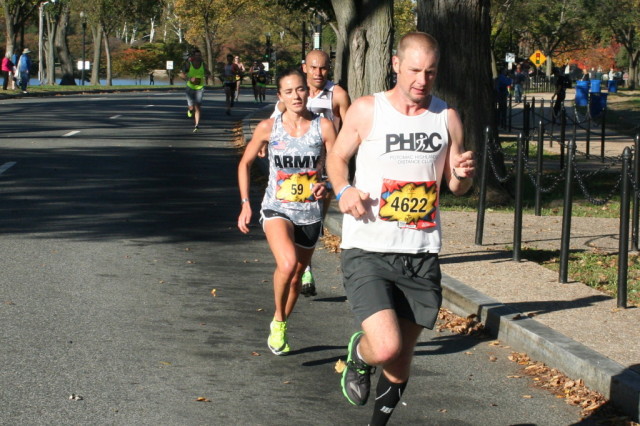

Kerri Gallagher will tell you 10 miles isn’t her specialty. And she has a point.
Last year, Gallagher was fifth in the 1500 meter run at the USA Track and Field Championships.
[button-red url=”https://www.armytenmiler.com/results/default.aspx?event=24297″ target=”_self” position=”left”] Results [/button-red]Well, on the side, Gallagher this morning became the first runner in the Army Ten-Miler’s 30-year history to win three straight overall titles, while also lowering her event record by six seconds to 54:50.
Marianne Dickerson won the first two ATMs, in 1985 and 1986, then won again in 1988. Next year, if Gallagher can make it a four-peat, she’ll tie Alisa Harvey for the most overall female titles.
After the race today, Gallagher remembered how her first ATM, in 2011, came as a bit of a shock. “I was surprised, because I wasn’t expecting to race it, and then he told me I was racing it,” she said, referring to her then-new coach, Matt Centrowitz.
If you train under Centrowitz, chances are ATM is on your schedule. Gallagher, who was a recent graduate of Fordham University with a degree in math and a school record for 800 meters, just didn’t know it at the time.
“I wasn’t quite strong enough to run 10, but I ran it,” she said, recalling her sub-60-minute debut, which put her more than three minutes behind the winner, Tezata Dengersa. The next year, though, even if 10 miles still wasn’t Gallagher’s favorite distance, she was ready: claiming her first victory in 56:09.
A three-year member of the Pacers-New Balance team, Gallagher recently became represented by Oiselle. By now, though, ATM is locked into Gallagher’s schedule. It’s a tradition. And she’ll be back next year for a shot at four titles.
“The energy is always so great here,” she said.
Gallagher was challenged in the early miles by U.S. Army Specialist Caroline Jepleting, who shares Gallagher’s background in middle distances. Jepleting was second in 56:34, putting her well ahead of Caitlin Bullock, of Durham, N.C., who was third in 57:17.
Born in Kenya, Jepleting came to the United States in 2008 to attend college. She was a 12-time national junior college All-American prior to transferring to Texas Tech, where she won a Big 12 cross country title.
Since coming to the United States, “I have always wanted to be in the military,” said Jepleting, who joined the Army about a year and a half ago and is now stationed in Germany. “It also is a way to celebrate the scholarship I got.”
Jepleting wasn’t sure if she would be able to continue running in the Army. “But I had that in mind: given a chance, I’d go for it,” she said.
She qualified to represent her unit’s team today by running a 61-minute qualifier in late June. Today, she easily exceeded her goal to break 60, and is already looking forward to next year.
“I think that is the greatest motivation,” she said of the 900 soldiers and civilians who support the event, as well as the spectators lining the course. “No matter how tired I was, I just kept moving.”
***
An hour before the first cannon fired this morning, members of the Brazilian Army team smiled while posing for a photo.
“Do you have the same team as last year?” the same team that swept the first three spots in 2013, a reporter asked.
“Yes,” a coach said. “Same team.”
You could not see Solonei Da Silva, Paulo Paula and Frank Almeida on the first row of the starting line. And in the opening mile, as an amateur runner sprinted out to a lead he would sustain for perhaps two minutes, the tall Da Silva, last year’s winner, ran fluidly with his teammates and let others set the pace.
The U.S. Army team, Aron Rono, Augustus Maiyo, Hillary Bor, and others – all athletes coached by Olympian and three-time ATM winner Dan Browne – had a similar strategy: run as a team, keep the group together as long as possible.
“We had decided we were going to take it really slow and try to bring the team together all the way towards the end,” Rono said.
As Siraw Gelaw opened up an early lead and passed through the mile in an honest 4:50, a huge mass of runners followed roughly 15 seconds back. Over the next few miles, a chase pack of 15 reeled him in, and Gelaw gladly settled back into the group.
Singlets – yellow for Brazil, gray camouflage for the Army, blue belonging to the U.S. Air Force and Frenchman Sebastien Beltran – stretched across Independence Avenue.
With a mile to go, one U.S. Army journalist captured the moment perfectly, saying, “Fifteen dudes have a shot.”
Chris Kwiatkowski, of Pacers New-Balance, was in the thick of it, just like last year. Ben Payne, of the U.S. Air Force, was often at the front and center of things. Two-time champion, Tesfaye Sendeku, Gelaw’s teammate, was there, too. Maiyo, former Marine Corps Marathon champion, was in the back, mostly hidden from sight.
“The last mile, I was a little disappointed, mainly because I was pushing the pace and the Brazilian team was really strong,” Rono said. When he surged, they surged back as if it were a game of speed-play.
There they were, sprinting towards the tape, with Da Silva defending his title in 48:28, just a second ahead of Paula. Almeida, in 48:45, edged out Rono, who moved up a spot from last year to fourth.
***
Thirty years ago, the first ATM had 1,379 runners. Today, there were 35,000 registered runners, 720 registered teams, and 11 shadow runs held all over the world. Retired Col. Lewis Goldberg was back for his 30th race, making him the only person to run in every ATM.
As runners filtered into the starting area for several wave starts on a chilly, sunny morning, the parachutes of the Army’s Golden Knights floated down from the sky. And about ten minutes before the first wave went off at 8 a.m., over 85 Wounded Warriors and wheelchair athletes – the heart and soul of ATM – were the first to cross the starting line.
One was Col. Greg Gadson, joined by five other handcyclists representing a team supported by America’s Fund. He has been competing in races on a handcycle – “an upside-down bicycle,” he said – since 2009.
Growing up, Gadson’s favorite sport was football. It was his skills as an outside linebacker that drew the attention of the United States Military Academy, and earned him a scholarship to play at West Point, leading him to a career as a soldier.
Gadson drew on that background after May 7, 2007. That day, in Baghdad, Iraq, Gadson was in a vehicle that was struck by a roadside bomb. His arm was badly injured; both of his legs had to be amputated above the knee.
“I think as a football player we always talk about getting knocked down and getting back up,” he said. “It’s a metaphor, but I think mentally that’s what you have to do.”
Gadson’s first Marine Corps Marathon as a handcyclist was hard, he said: “I thought I would never do it again.” Gadson has done three more marathons since.
After his injury, Gadson continued to serve in the military. He directed the Army’s Wounded Warrior program, he said, and, prior to retiring at the end of last year, was garrison commander for Fort Belvoir.
He is seeking out his next chapter in life, he said. Maybe he will even do more acting.
He also hopes, though, that he’ll have a little more time to get out on his hand-cycle through his neighborhood in Fairfax County and along the Mount Vernon trail.
“I want to keep a good cadence, keep a good rhythm,” he said. “Regardless of whether I am going uphill or downhill, I just try to find the right gear and keep that grind.”
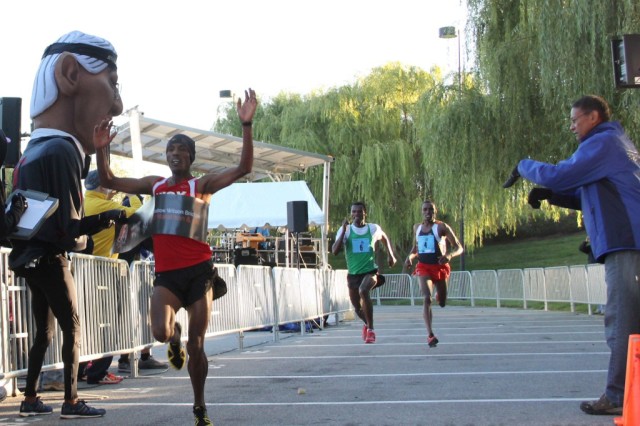
There was no calendar hopping this year for the Woodrow Wilson Bridge Half Marathon, the first of the region’s races to bear the brunt of the federal government shutdown last year. The race ended up postponed until early November, but temperatures were cooler in the fifth running in 2014, with runners bundled in spandex, hats and gloves in early October.
While many weren’t expecting the low temperatures, most runners were thrilled to race in the crisp and cool air so early in the fall.
“I don’t think it’s a hyperbole, I think the conditions were pretty perfect,” Kevin Ford said.
[button-red url=”http://results.chronotrack.com/event/results/event/event-10571″ target=”_self” position=”left”] Results [/button-red]The race serves as the Visually Impaired National Half Marathon Championship and turned out dozens of visually impaired athletes with the help of guides along their side. Erich Manser traveled all the way from the Boston area to compete in the race.
“I ran this course two years ago and I like the improvements they made,” Manser said. “As a visually impaired athlete, it made it a little user friendly for me.”
Nearly a year ago, Manser had knee surgery for a torn meniscus and had to take the rest of 2013 off. But he was able to start training again in January, made it through Boston, then completed a few triathlons. By late summer, Manser said he started to feel like he got his “groove back.”
“I’m not doing it without the guides,” Manser said. “It’s people that are so selfless and give up their own race to be out here. Such amazing athletes. Everyone’s got their own reason for being out here and it’s circular. You know, I love to feel like I inspire and I’m inspired by so many. It’s a wonderful thing.”
Alex Heiche and Laura Greason, also from the Boston area, helped guide Manser throughout the race. Both were pleasantly surprised with his pace.
“Erich gave us quite a challenge today to keep up with him,” Greason said.
The race featured generous cash prizes and attracted numerous elites to the field. Bobby Mack, member of the Reebok team, held the lead during the first three miles of the race.
“But for a half marathon that doesn’t really mean much,” Mack said.
Mack took the lead again near mile seven, but a pack of eight followed close behind and eventually overcame him. Once they reached mile 12, Girma Gebre, Gosa Tefera and Derege Demie broke away. The race came down to seconds, with Gebre breaking the tape at 1:03:50. Tefera finished second with the same tame as Gebre and Demie finished third one second later.
Mack said he plans to return to the area in November when he will compete in the .US National Road Racing Championships in Alexandria.
The female division also brought out fast elite runners, including Lilian Mariita (first) and Etaferahu Temesgen (second). The two held an impressive five-minute lead over the rest of the pack. Mariita crossed the line at 1:12:33 and Temesgen at 1:12:44. Joyce Kandie was the next female to come through with a time of 1:17:31.
The 13.1-mile course started in Mt. Vernon then headed north on the George Washington Parkway toward Alexandria, where runners were greeted with lots of crowd support. Then they crossed the Woodrow Wilson Bridge (as the name of the race suggests), which stretches out more than a mile and includes several rolling hills.
Roberto Rodriguez, who has run with DC Road Runners for 35 years, said this year’s race marked his fifth time crossing the bridge.
“I’ve run all five of them,” Rodriguez said. “You can’t argue with a day like today.”
Rodriguez also competed in last year’s race in November.
Some runners chose to defer their registrations a year after the race announced the new date, including Mark Njore of Dumfries, Va.
“I didn’t think I was ready,” Njore said. “It was a good excuse to defer. But I made sure to be ready this year.”
But by waiting a year, his friend Francis Agula was able to joined him in this year’s race.
The race seemed to attract many first-time half marathon finishers, including Alyssa Rucker who crossed the finish line with a Lack Braddock Cross Country shirt. Rucker said she picked a weekend that her cross country team didn’t have any meets to run a half marathon.
“I’ve been wanting to do [a half marathon] for a while,” Rucker said, and added that her coach had no idea about the race. “I’m sure he’ll find out at some point. Hopefully he’s okay with it. I did well so that’s good.”
Rucker said she’ll eventually complete a marathon but probably not for a couple of years.
“Hopefully sometime when I’m an adult,” she said.
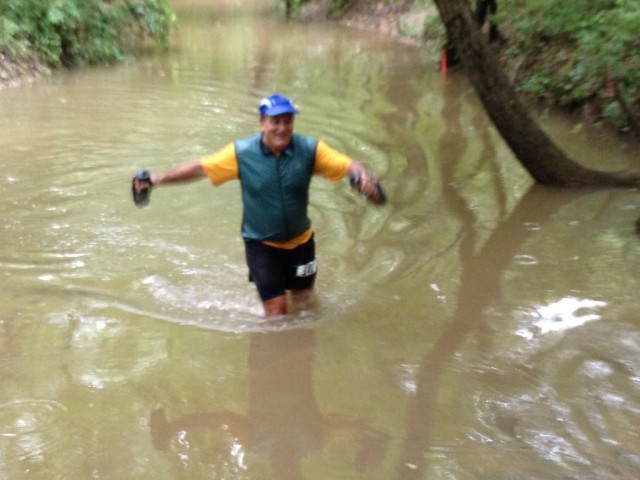
Working out the logistics for a 50-state marathon goal is almost just as difficult as completing 50 marathons. The list begins to add up quickly: race registration fees, cost for travel and accommodations, maneuvering time off of work, and the list goes on.
Race series have sprung up to give traveling runners a chance to knock out several states in one trip, often with races five days in a row. One such company, Altis Endurance Sports, based in Annapolis, brought that approach to the Potomac River, with five back-to-back trail marathons, in Meyersdale, Pa.; Keyser, W.V.; Frostburg, Md.; Annandale, Va. and Washington, D.C.
Thursday’s race, in Annandale’s Wakefield Park, brought out several of these so called “50-staters,” to run Fairfax’s Cross County Trail.
“Right now I’m at 30 states,” said Heather Gallacher who participated in the entire series so she could knock off five marathons in just a week. “And by Friday I’ll complete my 109th marathon.”
The Pennsylvania native said she had no idea D.C. was such a “trail running town”
“If you had never done any of these trails before it’s a great way to discover them,” she said. “I was blown away. That’s been one of the coolest things about this particular series—discovering the unknown. It was one of my most memorable runs and one I’ll never forget.”
Race directors Mike Samuelson and Frank Dembia head the endurance company and said last week’s series was hopefully one of several more events to come.
“I’ve been a long-time Rails-to-Trails Conservancy member,” Samuelson said. He earned fame in the ultrarunning community after completing a 3,302-mile run across the country in 80 consecutive days. “I’ve always loved rail trails and towpaths. They’re just so fantastic to run.”
According to Samuelson, Dembia had the idea to direct races more than 20 years ago. The two met in the Navy in California and completed several marathons and ultra marathons together. Once Samuelson finished his trans-America run, Dembia confronted him again with the idea to create the endurance company.
Their event on Thursday attracted a wide range of participants from all kinds of backgrounds, including 11-year-old Nikolas Toocheck of Chester County, Pa. Toocheck, who had the day off of school and came to Annadale with his father Dan, completed his seventh marathon on seven continents earlier this month and raised more than $40,000 for charity, providing coats to children through “Operation Warm.”
Toocheck snuck the marathon in between his wrestling and baseball practice.
“If you train really hard and put your heart to something you can accomplish it,” the 11-year old said.
The endurance series also included a half marathon. Former Washington, D.C.-area resident Julie Crespi won the women’s half for Thursday’s event. Crespi came down for the series from Rhode Island.
“I was going to come visit a friend in the area and saw a Thursday race,” Crespi said. “And then I saw there was an entire series. So I figured I could drive down and hit them all along the way.”
The cross country course was changed just moments prior to the race due to flooding of the trail system in Wakefield Park. The area received several inches of rain the night before and the sky continued to pour during the morning hours of the race as well. But even with a course change, runners still dealt with slick terrain and even waded through a deep gully that went past most runners’ knees.
“What I love is having something to stick in my mind for one of these,” said Marvin Solberg, who had just completed his seventh marathon of the year and has a long-term goal to eventually complete all 50 states. “The start was classic. We all went astray. We all went past the gully and went the wrong way.”
Runners completed more than 10 loops along the course to reach 26.2 miles, which meant they had to wade through the same gully several times.
But Solberg said he didn’t hear a single complaint from any of the runners.
“It’s part of the excitement of hanging out with people like this,” he said. “It’s very positive energy and everyone that was here just did it. Running marathons is all about overcoming adversity. So when little things like that arise, it’s just part of the fun.”
For 2015, race directors Samuelson and Dembia are planning a nine-state marathon series in Maine, Vermont, New Hampshire, New York, Massachusetts, Rhode Island, Connecticut and Pennsylvania.
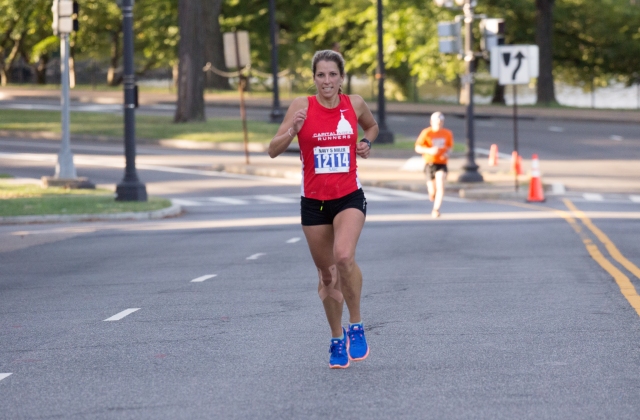
Many runner notched new personal records – and broke some course records as well – on a beautiful morning at the Navy-Air Force Half Marathon.
[button-red url=”http://www.zippyraceresults.com/search.php?ID=4284″ target=”_self” position=”left”] Half Marathon Results [/button-red]Erin Taylor, who runs with Capital Area Runners, had hoped to finish in the top three, but ended up winning the half marathon for the women in 1:20:36, getting a new PR and breaking the course record, despite running much of the course on her own.
“[button-red url=”http://www.zippyraceresults.com/search.php?ID=4285″ target=”_self” position=”left”] Five Mile Results [/button-red]I tried to go out with two guys on my team, which I did for about a mile and a half, but then I just thought, they’re going out too fast for me. So I literally did run the entire race by myself, which is probably why I’m most happy about my time,” the Arlington resident said. “That was a little rough, I really wasn’t with anyone.”
Taylor is training for the Marine Corps Marathon at the end of October, and said she hopes to be able to tuck in with some other women and not spend any of the race by herself.
The half marathon course begins by the Washington Monument and goes along the mall before about a two mile out-and-back on the Rock Creek Parkway. After crossing the Memorial Bridge, runners retrace their steps into the city and make a loop around Hains Point before finishing at the monument again.
For Taylor, the best part was the run in Rock Creek Park.
“I thought I would hate it because it’s the big hill, but it’s actually really beautiful there, it made it really nice,” she said.
Patrick Fernandez, also from Capital Area Runners, took the top spot in the men’s half marathon in 1:07:54, just two seconds slower than the course record he set last year.
“We were really in a big pack for the first half of the race, then mile six or seven, coming right out of Rock Creek when it started to flatten out is when I made my move,” Fernandez said. “From there I was kind of running by myself. I had to run my own race.”
The active duty Coast Guardsman used Sunday’s race as a physical and mental tune up for next month’s Eindhoven Marathon in the Netherlands, where he’ll race with the armed forces marathon team.
“This is actually my first internal race,” Fernandez said. “Based on how I did at the Marine Corps Marathon last year, I was lucky enough to get selected to compete with the team this year in the Netherlands.”
Both the male and female top masters finishers also set new course records.
Thomas Adam, who runs for Ragged Mountain Racing in Charlottesville and won the 5 miler, said he planned to stick with a members of the Georgetown Running Club at the start, but slowly pulled away in about the last mile.
A highlight of the course for Adam for the loop around Hains Point, though other runners said they were bored during the three mile loop.
“It’s kind of relaxing and calming being on that loop because it’s quiet, you’re near the water, it’s a beautiful day. So I just tried to focus on staying relaxed,” he said.
Following his win on Sunday, Adam will be back in D.C. for the Army Ten-Miler in early October and is also training for the Indianapolis Monumental Half Marathon in November.
Maura Carroll, who runs for the Georgetown Running Club, won the 5 miler for the women in about 30 minutes. While she was happy with her time, she said she wished there have been more people with her during the race to pull her along a bit faster.
“I was expecting there to be a few more people who were running around the pace I was,” she said. “After the first mile or so, I was pretty much alone, so that was kind of hard through Hains Point. Just hard to stay focused and it was kind of windy.”
Carroll was one of the people who missed the early start of the 5 miler in 2013, but said everything went smoothly at this year’s start.
“I was glad it started on time this year, I missed the start last year, so that was not great,” she said. “It was a lot less stressful.”
Her next race will be a 10k in Pittsburgh later this month, then the Army Ten-Miler in October.
Jeff Lewis, an Army veteran who competed in the wheelchair division, said when he stopped peddling a few times during the race, he realized that his muscles were tightening up in the cold. That motivation to keep peddling – as well as staying focused on the police motorcycle ahead of him – enabled him to win the 5 mile wheelchair division.
Lewis was racing in honor of Private First Class Adam Marion, who he served with in Iraq.
“He lost his life April 28, 2008,” Lewis said. “He was taken out by mortar rounds. A young, bright kid, a lot going for him. Just taken out of the game way too early.”
Nathan Nudelman, the coach of the Naval Academy Marathon Team, brought 19 students to the race from Annapolis for their last tune up before they end the season at the Steamtown Marathon in Pennsylvania in October.
One of them, Greg Marshall, a senior at the Naval Academy, ran the five mile race Sunday as part of the taper for the upcoming marathon. While the schedule at the academy is demanding, Marshall said it’s not a burden to fit in a run at the end of a long day.
“I kind of needed it. It’s great to go to school all day and have that stress you out, then hang out with some of my best friends, get a good run in. It’s definitely a good escape,” he said.
After the race, Adm. James Winnefeld, the vice chairman of the joint chiefs of staff, who ran the half marathon, spoke with the Naval Academy students about his 36-year career in the Navy and as a runner.
“It’s really humbling,” Marshall said. “To see that he took the example same path I did and is still running half marathons is pretty inspiring. It’s definitely a good person to emulate I think as I go into my career. I have no clue if I’ll be in for 36 years but until I hit that mark, I probably shouldn’t stop running because he didn’t.”
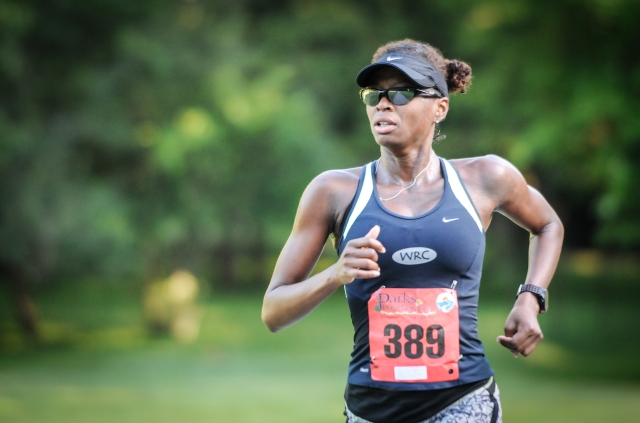
Siraw Kebede might have run a little faster on more than two hours of sleep, but not much.
[button-red url=”http://www.mcrrc.org/parks-half-marathon-men-1″ target=”_self” position=”left”] Men’s Results [/button-red]The Parks Half Marathon winner got in from New York at about 3 a.m., the morning after he ran 4:05.3 to win the New York Road Runners Road Mile division at the Fifth Avenue Mile.
[button-red url=”http://www.mcrrc.org/parks-half-marathon-women-1″ target=”_self” position=”left”] Women’s Results [/button-red]With a 1:03 PR, Kebede has run faster, but it wasn’t the sleep that did him in, even as he struck out on his own five miles in to put a gap on Tilahun Manesho, who finished second in 1:08:33.
“The course,” he said. “The hills, up and down, you can’t run as fast.”
That didn’t stop Bill McNary, who ran 10 minutes faster than his previous best on the course. He lives in Bethesda, runs parts of the point-to-point course between Rockville and Bethesda, and saw his wife and two children on the course.
“When I turned 40 I lost 35 pounds and suddenly got as fast as I was in high school,” he said. “The last year’s been very good.”
The key, for him, was restraint early on.
“The first two miles are downhill, so you can’t trust those splits for the rest of the race,” he said. “Those last two miles, you just can’t speed up.”
Julia Taylor of Arlington was on board with that strategy.
“I went too fast last year, so I was sure to not do that this year,” she said. “When you pay the price like I did last year, it reins you in.”
White Marsh, Md. resident Megan Digregorio didn’t PR overall, but she also had a big improvement over her first two times racing the course. She ran stronger throughout the entire race than she had before, and that showed in her 32-second win over Megan Haberle of Takoma Park. Digregorio will take her momentum to the Wineglass Marathon, a race she deferred in 2013.
“I found a good pack of guys to run with,” she said. “I prefer to run with people, it keeps my mind off the pain. It helps break up the race.”
When she approached the finish line in Bethesda’s Elm Street Park, she was surprised to have finished first.
“I usually finish in the top five, but I never thought I’d win it,” she said. “I kept expecting another woman to pass me, but it never happened.”
The East African runners who have swept the women’s top three over the last three years were absent, due perhaps to their refusal to pay the entry fee the day before the race.
“We try to accommodate elite runners with complimentary entries, but we do that in the weeks before the race, not the day before,” said race director Mike Acuña. “They balked at that.”
After nine years at the helm of the race that RunWashington readers voted as offering the best post-race party and best t-shirt, Acuña is retiring and leaving the event in Don Shulman‘s hands, following a short apprenticeship and a shared role as race directors this year.
* * *
Baltimore’s Naomi Blaushild ran a five-minute PR, over her time from the similarly hilly Baltimore Half Marathon.
“Being from Western Pennsylvania, this isn’t too bad,” she said. She’s moving up to the Baltimore full in a few weeks. “It’s a good training run for me.
“It was one of my first races with a garmin. I tried not to look at it too much, but the 1:50 pace group was behind me and every time I heard them coming, I’d speed up.”
A fan of wooded courses, “I did a good job of not getting mentally lost out there,” she said.
Even after they crossed the finish line, the day wasn’t over for Marty Janis and Rick Horn, both of Potomac. They unwittingly both dressed for the race in identical Philadelphia Marathon shirts, the target of their fall training, and soon after finishing the race were headed out for a few more miles on the Capital Crescent Trail.
“We ran relaxed with some friends until mile 11, then kicked it in and added some misery,” Janis said.

